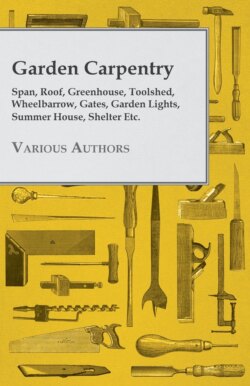Читать книгу Garden Carpentry - Span, Roof, Greenhouse, Toolshed, Wheelbarrow, Gates, Garden Lights, Summer House, Shelter Etc. - Various - Страница 9
На сайте Литреса книга снята с продажи.
GARDEN SEAT
ОглавлениеFIG. 1. ORNAMENTAL AS WELL AS USEFUL.
Oak or teak are first choice, but larch makes a quite satisfactory alternative. Length 4 ft. 6 ins.
FIG. 2. SCALE WORKING DRAWINGS, END AND FRONT ELEVATIONS, PLANS, ETC.
FIG. 3. HOW PROVISION IS MADE FOR SLOPING BACK. ALSO DETAILS OF FRONT LEG.
IN making a garden seat, always aim at rigidity. Do not stint the thickness. You sit out of doors to relax, and the greater your sense of security the better you understand what complete abandonment to effortless relaxation really means. Aim, too, at comfort, provision for which can be made under three general heads: (1) A height at which you may sit at ease; (2) a front-to-back depth of seat which will afford adequate rest for the legs; and (3) a rake which will support the body without throwing it too far back. There must, of course, be variation (within limits) according to height and build of sitter, but in the seat shown the average has been considered. Height of seat is 15 ins., tilting to 14 1/2 ins. at back. (This will allow for light cushions.) Depth of seat is 20 ins. from front to line of lower back rail. Rake of back is 2 1/2 ins., this being arranged without involving waste in cutting shaped back legs.
The cost of timber for a garden seat is not unduly heavy even if oak is selected. Failing this, there is larch, although (if available at present) the red Baltic pine, commonly known as red deal, will serve admirably if kept well painted. The length of seat shown is 4 ft. 6 ins., but it may be anything from 4 ft. to 5 ft., always bearing in mind that the larger size is more economical in the long run.
Ends.—Front legs are 2 1/2 ins. square; back legs 3 ins. by 2 ins. The reason for this latter size is that the back legs may be kept straight, the rake being effected by the placing of the back rails. Front legs are chamfered on the two front edges, the upper part being stop-chamfered also on the back edges. All legs are mortised for the seat rails and stretcher rails, noting that the seat at back is 1/2 in. lower than at front. The front legs have 5/8 in. stub tenons to enter the arms (see Fig. 3). Back legs, tapered and shaped at top, are mortised for back rails and either mortised or notched for arms. When assembling the ends, fit the joints with red lead paint (thick). Cramp up well.
Assembling.—Prepare the back, carefully spacing for the splats (K) which are tongued to rails (H and J). Note that splats are flush with rails on face. Turning to Fig. 3, observe that, whilst the lower rail (J) is kept flush with front face of back legs, the upper rail (H) is thrown towards the rear face—this to provide for the rake. Adjust the mortises accordingly. The lower rail (J) will have a shouldered tenon; the upper one (H) a barefaced tenon so that the back of rail slightly overlaps the leg.
With the long seat rails (E) ready, assemble the seat. The cross rail (F) and the long stretcher (G) may be dovetail housed. Should the worker prefer front and back underframe rails instead of the single stretcher, these may be tenoned to legs, raising the rails an inch or more so that the tenons clear those of rails (D). Peg the tenons. Again see that all joints are well painted. Test the piece for squareness and cramp up.
Arms are 4 1/2 ins. wide at front and 3 3/4 ins. or 4 ins. at back. At back they are either tenoned or notched to leg; at front they overhang the leg by 2 ins, (shaping as indicated) and are held by stub-tenoning and pegging. Round the corners front and back and take the arris off upper and under edges.
For the seating it is wise to use 4 ins. wide boards at front and back. Let the front board overhang an inch, rounding the edges over at end. All boards slightly overhang the seat rails (C). Screw down, countersinking well for the heads.
If to be painted, give a priming of red lead, followed by at least two coats of oil paint. If a preservative such as creosote is preferred give three dressings.
CUTTING LIST
Lengths allow for joints and fitting. Thicknesses are net.
